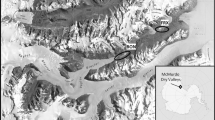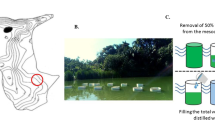Abstract
Phytoplankton batch cultures were used to study the effect of biologically and chemically treated wastewater on algal growth in water from Lake Zürich. The question of whether the influence of sewage on the biomass production corresponds solely to the nutrient content of the sewage was also considered. The relationship between net microbial production (y, in 0.1 N KMnO4 consumption) and total phosphorus concentration (x, in µg P/1) was found to be characterized by the equation y = 2.12 ln x − 4.12. The fact that net microbial production is strongly dependent on total phosphorus concentration emphasizes the significance of the latter for the trophic state of Lake Zürich. We recommend the introduction of additional purification of all sewage entering the lake.
Similar content being viewed by others
References
American Public Health Association, 1975. Standard methods for the examination of water and wastewater. Washington, 1193 pp.
Betschart, B., 1979. Die Verwendung von Biotesten zur Untersuchung des eutrophierenden Einflusses der Zürcher Abwässer auf die Limmat. Ph.D. Thesis, University of Zürich, Switzerland, 84 pp.
Bómbowna, M. & H. Bucka, 1972. Bioassay and chemical composition of some Carpathian rivers. Verh. int. Ver. Limnol. 18: 735–741.
Bossard, P. & H. Ambühl, 1974. Der Einfluss von gereinigtem Abwasser auf das Phytoplankton in Seen. Schweiz. Z. Hydrol. 36: 187–200.
Chiaudini, G. & M. Vighi, 1974. The N: P ratio and tests with Selenastrum to predict eutrophication in lakes. Wat. Res. 8: 1063–1069.
Claesson, A. & A. Forsberg, 1978. Algal assay procedure with one or five species. Minitest. Mitt. int. Ver. Limnol. 21: 21–30.
Couture, P., S. A. Visser, R. Van Coillie & C. Blaise, 1985. Algal bioassays: their significance in monitoring water quality with respect to nutrients and toxicants. Schweiz. Z. Hydrol. 47: 127–158.
Deutsche Einheitsverfahren zur Wasser-, Abwasser- und Schlammuntersuchung, 1981. Lieferungen 1–9. Verlag Chemie, Weinheim/Bergstr., BRD, 257 pp.
Dunstan, W. & D. Menzel, 1971. Continuous cultures of natural populations of phytoplankton in dilute, treated sewage effluent. Limnol. Oceanogr. 16: 623–632.
Eidgenössische Richtlinien für die Untersuchung von Abwasser und Oberflächenwasser, 1982. Eidgenössisches Departement des Innern, Bern, 68 pp.
Forsberg, A. & A. Claesson, 1981. Algal assays with wastewater to determine the availability of phosphorus for algal growth. Verh. int. Ver. Limnol. 21: 763–769.
Gargas, E., 1978. The effect of sewage (mechanically, biologically and chemically treated) on algal growth. Mitt. int. Ver. Limnol. 21: 110–124.
Gaur, J. P. & H. P. Kumar, 1986. Effects of oil refinery effluents on Selenastrum capricomutum Printz. Int. Rev. Ges. Hydrobiol. 71: 271–281.
Hecky, R. E. & P. Kilham, 1988. Nutrient limitation of phytoplankton in freshwater and marine environments: a review of recent evidence on the effects of enrichment. Limnol. Oceanogr. 33: 796–822.
Källqvist, T., 1975. Algal growth potential of six Norwegian waters receiving primary, secondary and tertiary sewage effluents. Verh. int. Ver. Limnol. 19: 2070–2081.
Miller, W. E. & T. E. Maloney, 1971. Effects of secondary and tertiary wastewater effluents on algal growth in a lake-river system. J. Wat. Pollut. Cont. Fed. 42: 2361–2365.
Mitscherlich, E. A., 1909. Das Gesetz vom Minimum und das Gesetz des abnehmenden Bodenertrags. Landw. Jahrb. 38: 537–552.
Redfield, A. C., 1958. The biological control of chemical factors in the environment. Amer. Sci. 46: 205–221.
Sachs, L., 1974. Angewandte Statistik. Springer Verlag, Berlin, BRD, 548 pp.
Schanz, F., 1974. Wachstumsansprüche der Cladophoracee Rhizoclonium hieroglyphicum Kütz. in Reinkultur. Ph.D. Thesis, University of Zürich, Switzerland, 140 pp.
Schanz, F. & P. Pleisch, 1981. Bioteste zum Vergleich von drei neuen, parallel betriebenen Verfahren zur weitestgehenden Phosphor-Elimination (4. Reinigungsstufe). Gas Wass. Abwass. 61: 6–11.
Schanz, F. & H. Juon, 1983. Two different methods of evaluating nutrient limitations of periphyton bioassays using water from the river Rhine and eight of its tributaries. Hydrobiologia 102: 187–195.
Sokal, R. R. & F. J. Rohlf, 1969. Biometry. W. H. Freeman & Comp., San Francisco, 776 pp.
Thomas, E. A., 1953. Empirische und experimentelle Untersuchungen zur Kenntnis der Minimumstoffe in 46 Seen der Schweiz und angrenzender Gebiete. Monatsbull. Schweiz. Ver. Gas Wasserfachmänner 9: 1–15.
Thomas, R. L. & M. Munawar, 1985. The delivery and bioavailability of particulate bound phosphorus in Canadian rivers tributory to the Great Lakes. In J. N. Lester & P. W. W. Kirk (eds.), Proc. Internat. Conf.: Management Strategies for phosphorus in the Environment. Lisbon, Portugal, 462–469 pp.
Wagner, R., 1969. Neue Aspekte in der Stickstoff-Analytik. Vom Wass. 36: 263–328.
Author information
Authors and Affiliations
Rights and permissions
About this article
Cite this article
Lehmacher, C., Schanz, F. Examination of the effect of wastewater on the productivity of Lake Zürich water using indigenous phytoplankton batch culture bioassays. Hydrobiologia 188, 229–235 (1989). https://doi.org/10.1007/BF00027788
Issue Date:
DOI: https://doi.org/10.1007/BF00027788




